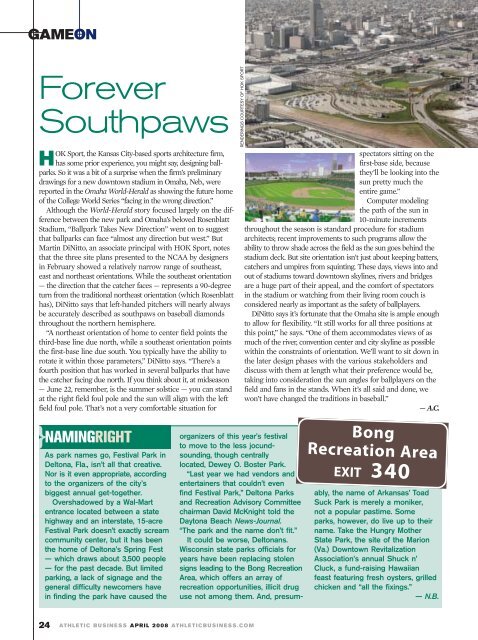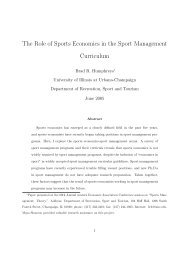Environmental Education
Environmental Education
Environmental Education
Create successful ePaper yourself
Turn your PDF publications into a flip-book with our unique Google optimized e-Paper software.
GAMEON<br />
Forever<br />
Southpaws<br />
HOK Sport, the Kansas City-based sports architecture firm,<br />
has some prior experience, you might say, designing ballparks.<br />
So it was a bit of a surprise when the firm’s preliminary<br />
drawings for a new downtown stadium in Omaha, Neb., were<br />
reported in the Omaha World-Herald as showing the future home<br />
of the College World Series “facing in the wrong direction.”<br />
Although the World-Herald story focused largely on the difference<br />
between the new park and Omaha’s beloved Rosenblatt<br />
Stadium, “Ballpark Takes New Direction” went on to suggest<br />
that ballparks can face “almost any direction but west.” But<br />
Martin DiNitto, an associate principal with HOK Sport, notes<br />
that the three site plans presented to the NCAA by designers<br />
in February showed a relatively narrow range of southeast,<br />
east and northeast orientations. While the southeast orientation<br />
— the direction that the catcher faces — represents a 90-degree<br />
turn from the traditional northeast orientation (which Rosenblatt<br />
has), DiNitto says that left-handed pitchers will nearly always<br />
be accurately described as southpaws on baseball diamonds<br />
throughout the northern hemisphere.<br />
“A northeast orientation of home to center field points the<br />
third-base line due north, while a southeast orientation points<br />
the first-base line due south. You typically have the ability to<br />
rotate it within those parameters,” DiNitto says. “There’s a<br />
fourth position that has worked in several ballparks that have<br />
the catcher facing due north. If you think about it, at midseason<br />
— June 22, remember, is the summer solstice — you can stand<br />
at the right field foul pole and the sun will align with the left<br />
field foul pole. That’s not a very comfortable situation for<br />
}<br />
NAMINGRIGHT<br />
As park names go, Festival Park in<br />
Deltona, Fla., isn’t all that creative.<br />
Nor is it even appropriate, according<br />
to the organizers of the city’s<br />
biggest annual get-together.<br />
Overshadowed by a Wal-Mart<br />
entrance located between a state<br />
highway and an interstate, 15-acre<br />
Festival Park doesn’t exactly scream<br />
community center, but it has been<br />
the home of Deltona’s Spring Fest<br />
— which draws about 3,500 people<br />
— for the past decade. But limited<br />
parking, a lack of signage and the<br />
general difficulty newcomers have<br />
in finding the park have caused the<br />
organizers of this year’s festival<br />
to move to the less jocundsounding,<br />
though centrally<br />
located, Dewey O. Boster Park.<br />
“Last year we had vendors and<br />
entertainers that couldn’t even<br />
find Festival Park,” Deltona Parks<br />
and Recreation Advisory Committee<br />
chairman David McKnight told the<br />
Daytona Beach News-Journal.<br />
“The park and the name don’t fit.”<br />
It could be worse, Deltonans.<br />
Wisconsin state parks officials for<br />
years have been replacing stolen<br />
signs leading to the Bong Recreation<br />
Area, which offers an array of<br />
recreation opportunities, illicit drug<br />
use not among them. And, presum-<br />
24 ATHLETIC BUSINESS APRIL 2008 ATHLETICBUSINESS.COM<br />
RENDERINGS COURTESY OF HOK SPORT<br />
spectators sitting on the<br />
first-base side, because<br />
they’ll be looking into the<br />
sun pretty much the<br />
entire game.”<br />
Computer modeling<br />
the path of the sun in<br />
10-minute increments<br />
throughout the season is standard procedure for stadium<br />
architects; recent improvements to such programs allow the<br />
ability to throw shade across the field as the sun goes behind the<br />
stadium deck. But site orientation isn’t just about keeping batters,<br />
catchers and umpires from squinting. These days, views into and<br />
out of stadiums toward downtown skylines, rivers and bridges<br />
are a huge part of their appeal, and the comfort of spectators<br />
in the stadium or watching from their living room couch is<br />
considered nearly as important as the safety of ballplayers.<br />
DiNitto says it’s fortunate that the Omaha site is ample enough<br />
to allow for flexibility. “It still works for all three positions at<br />
this point,” he says. “One of them accommodates views of as<br />
much of the river, convention center and city skyline as possible<br />
within the constraints of orientation. We’ll want to sit down in<br />
the later design phases with the various stakeholders and<br />
discuss with them at length what their preference would be,<br />
taking into consideration the sun angles for ballplayers on the<br />
field and fans in the stands. When it’s all said and done, we<br />
won’t have changed the traditions in baseball.”<br />
— A.C.<br />
Bong<br />
Recreation Area<br />
EXIT 340<br />
ably, the name of Arkansas’ Toad<br />
Suck Park is merely a moniker,<br />
not a popular pastime. Some<br />
parks, however, do live up to their<br />
name. Take the Hungry Mother<br />
State Park, the site of the Marion<br />
(Va.) Downtown Revitalization<br />
Association’s annual Shuck n’<br />
Cluck, a fund-raising Hawaiian<br />
feast featuring fresh oysters, grilled<br />
chicken and “all the fixings.”<br />
— N.B.
















